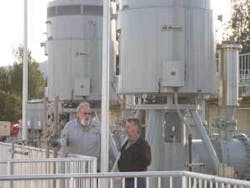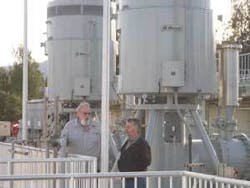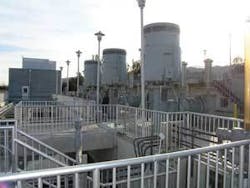Wastewater treatment plant achieves energy and resource savings with efficient design
Engineers of the US utility PG&E Technical and Land Services Department worked with managers at the Dublin San Ramon Services District to save energy and resources through design changes at a wastewater treatment plant.
by Robert Bruce Lung
Before expanding their wastewater treatment plant, managers at the Dublin San Ramon Services District (DSRSD) explored ways to make the design more energy efficient.
Their goal was to reduce total energy use of treatment processes and gain the ability to recycle treated water while increasing plant capacity. To determine how to achieve their goal, they worked with engineers from PG&E’s Technical and Land Services Department, who analyze new or expanding industrial plants under the statewide investor-owned utility sponsored energy efficiency program, Savings By Design (SBD). This expansion project enabled the DSRSD to process 48 percent more wastewater more efficiently.
The DSRSD operates a regional wastewater treatment facility serving more than 120,000 residents in the San Ramon area. Before the redesign project, the plant treated approximately 11.5 million gallons per day using an activated sludge process with effluent filtering and fine bubble aeration. Due to population growth, it became necessary to expand the plant’s treatment plant capacity to 17 million gallons per day. DSRSD also decided to construct a new fresh water distribution facility and a new facility to recycle water for irrigation.
The plant needed more aeration tanks and greater aeration blower capacity to meet expansion requirements. Aeration fans can account for as much as half of a wastewater treatment plant’s total energy consumption, so DSRSD staff were particularly vigilant about the efficiency of this process. The engineering analysis showed a single-stage fan was more costly than a multi-stage unit, but the annual energy consumption was 31 percent lower. This convinced DSRSD management to install the single-stage aeration fans.
To maximize overall plant energy efficiency, DSRSD implemented several additional energy efficiency measures that qualified for SBD incentives. In the secondary treatment process, they installed premium efficiency motors on the pumps and redesigned the system to reduce head loss. Existing pumps were already fitted with high efficiency motors, but DSRSD personnel felt that the extra savings afforded by premium efficiency motors would help mitigate potential increases in energy costs.
The existing secondary treatment process required the effluent to be pumped against 5.75 feet of head before reaching the effluent pump suction well. This caused the plant to use more energy to move the effluent. To improve this situation, DSRSD personnel redesigned the secondary treatment process by raising the water level in the secondary sedimentation tank and locating the recycled water facility closer to the process. Recycling the water eliminated the need to pump the effluent 20 miles away into the San Francisco bay.
DSRSD staff evaluated two different types of ultraviolet (UV) lamps for the purpose of disinfecting recycled water. The UV lamp system selected was 50 percent more costly and required more space, but it was 64 percent more efficient than the alternative. This increase in energy efficiency was too compelling to decline. Finally, staff at the DSRSD decided to install premium efficiency pump motors with variable speed drives (VSD) on the recycled water effluent pumps. While the alternative, fixed-speed pumps, were less costly and capable of managing fluctuations in flow rates, the greater energy efficiency of the premium efficiency VSD units enabled the DSRSD to meet their goal of maximum energy efficiency.
Project successes and lessons
DSRSD increased the capacity of their wastewater treatment plant and improved the energy efficiency of the overall plant. They are now able to treat 48 percent more wastewater for the residents of Dublin and San Ramon. The plant’s annual energy use savings were estimated to be 2,232,000 kWh and the annual energy cost savings were estimated to be US$ 290,000. This enabled the DSRSD to earn a total of $67,000 in incentives from PG&E. The new plant cost an additional $2,209,000 more than a less efficient one, yielding a simple payback of 6.6 years.
Author’s Note
Robert Bruce Lung is a senior associate of Resource Dynamics, based in Vienna, Virginia, USA.
Plant description
Wastewater Treatment plants use large amounts of electricity to drive pumping and aeration systems, as well as other crosscutting technologies essential to the treatment process. When a wastewater treatment plant is built or upgraded, proper design and configuration of these systems is essential for optimal performance and energy efficiency.
Variable frequency drives optimize energy savings on the effluent pump motors at the DSRSD wastewater treatment plant.


